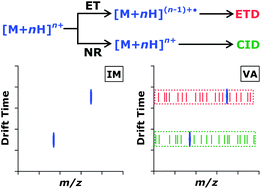Obtaining complementary polypeptide sequence information from a single precursor ion packet via sequential ion mobility-resolved electron transfer and vibrational activation†
Abstract
Tandem mass spectrometry (MS/MS) is now well-known as a powerful tool for characterizing the primary structures of peptides and proteins; however, in many cases the use of but a single dissociation method provides only a partial view of the amino acid sequences and post-translational modification patterns of polypeptides. While the application of multiple fragmentation methods can be more informative, this introduces the burden of acquiring multiple MS/MS spectra per analyte, thus reducing the effective duty cycle of such methods. In this work, initial proof-of-concept is provided for a method designed to overcome these barriers. This method relies on the complementary fragmentation information that can be provided by performing collision-induced dissociation (CID) and electron transfer dissociation (ETD) in concert, while also taking advantage of an ion mobility (IM) dimension to temporally resolve the occurrence of CID and ETD when applied to a single accumulated packet of precursor ions. In this way, the significant proportion of the precursor ion population that remains unreacted in ETD experiments is subjected to CID rather than being fruitlessly discarded. In addition, the two distinct fragmentation spectra can be extracted from their corresponding IM domains to render readily interpretable individual fragmentation spectra. This scheme was demonstrated for several polypeptides ranging from 1.3 to 8.6 kDa in molecular weight. In each case, IM-resolved CID and ETD events resulted in b/y and c/z ions, respectively, which each covered both unique and overlapping sequence information. These findings demonstrate that the combination of CID and ETD can be achieved with greater utilization of the available ion population and little or no loss of duty cycle.


 Please wait while we load your content...
Please wait while we load your content...